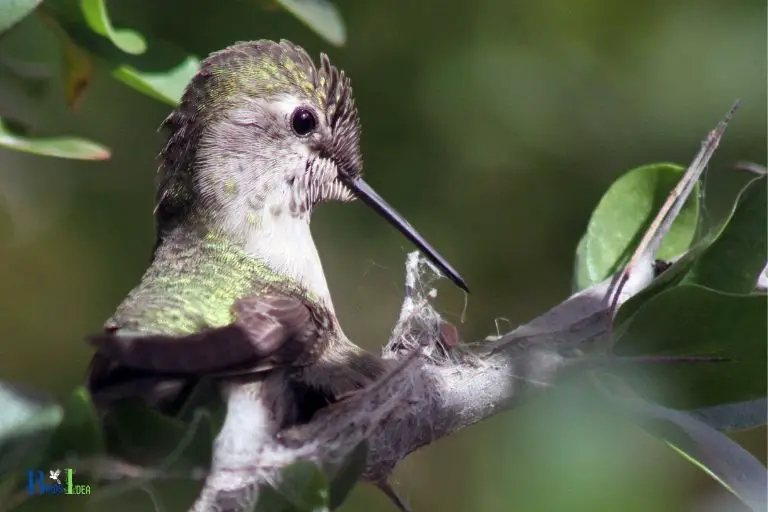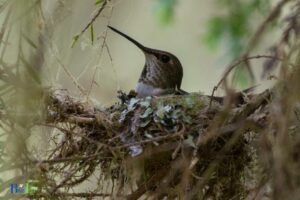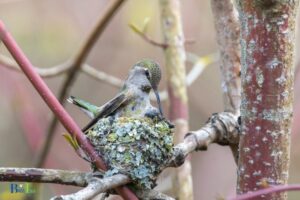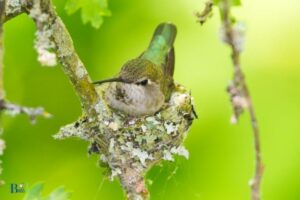What Time of Year Do Hummingbirds Nest? Early Spring!
Hummingbirds generally nest during the early spring to late summer months, with the specific time frame varying depending on the species and regional climate.
During the nesting season, hummingbirds establish territories and select suitable nesting sites.
These small birds are meticulous in their choice of location, as it contributes significantly to the survival of their offspring.
They typically look for areas with abundant food, shelter, and protection from potential predators.
During the nesting season, female hummingbirds are responsible for constructing the small cup-shaped nest, usually about the size of a walnut half.
They use a combination of plant fibers, spider silk, and lichen to create a strong, yet flexible structure that can expand as the chicks grow.
Once the nest is complete, the females will lay two eggs and incubate them for about two weeks before they hatch.
The mother continues to feed and care for her chicks for another three to four weeks, until they are ready to fledge and become independent.
Time & Location of Hummingbirds Nesting
| Region | Nesting Period Start | Nesting Period End |
|---|---|---|
| North America | Late February | Early August |
| Central America | Year-round | Year-round |
| South America | September | March |
Key Takeaway

Five Facts About Hummingbird Nesting
Understanding The Hummingbird Nesting Behavior
Hummingbirds are fascinating creatures, known for their unique aerial abilities and vibrant colors. However, they also have interesting nesting behaviors that are worth exploring.
In this post, we will discuss how hummingbirds choose their nesting sites, the typical nest locations, and why they build multiple nests.
How Do Hummingbirds Choose Their Nesting Sites?
Hummingbirds are picky about their nesting sites, as they have a few specific requirements.
Here are some key points to consider when answering how hummingbirds choose their nesting sites:
- Hummingbirds prefer to build their nests in areas that provide shelter from severe weather conditions, such as strong winds and direct sunlight.
- They typically choose a location that is less than 15 feet off the ground, which allows them to easily access their nests and protect them from predators.
- Hummingbirds prefer to build their nests in areas with dense foliage, as it provides excellent protection from predators and the elements.
- They also prefer to build their nests in areas with a good source of food nearby, such as trees and flowers, which can provide them with a steady supply of nectar, insects, and other food sources.
What Are The Typical Nest Locations For Hummingbirds?
Hummingbirds build their nests in a variety of locations, but there are a few typical nest locations to consider.
Here are some key points to consider:
- Hummingbirds typically nest in deciduous or coniferous trees, shrubs, or vines.
- They sometimes build their nests in artificial structures, such as eaves, wire, or string.
- Hummingbird nests are usually built in areas that are partially sheltered and provide ample shade.
- They might also build their nests on the branches of trees and shrubs, or on objects such as wires and clotheslines.
Why Do Hummingbirds Build Multiple Nests?
Hummingbirds have a unique nesting behavior, which involves building multiple nests in the same season.
Here are some key points to consider:
- Hummingbirds build multiple nests to provide backup options if one nest becomes damaged or lost.
- They might also build multiple nests to lure predators away from the primary nest.
- Building multiple nests allows hummingbirds to prepare for future breeding seasons by having several options available.
- Each nest may also serve a different purpose, such as a nesting site or a roosting spot.
Understanding the nesting behavior of hummingbirds can be fascinating and insightful. By knowing how they choose their nesting sites, where they typically build their nests, and why they build multiple nests, we can appreciate these tiny birds even more.
An Overview Of The Hummingbird Nesting Season
Hummingbirds are one of the most attractive and adorable species of birds, and they are highly admired for their agility, beauty, and acrobatic display.
Hummingbirds, unlike other birds, have unique motion capabilities, and they are the smallest bird species worldwide.
They are called hummingbirds because of the humming sound their wings make while in flight. While most birds tend to migrate from one location to another, hummingbirds are known to have a nesting season.
In this blog post, we will examine the hummingbird nesting season, what period hummingbirds start nesting, how long the nesting season lasts, and what happens to their nests after the nesting season.
When Do Hummingbirds Start Nesting?
Hummingbirds have a shorter life span than other bird species; thus, they tend to nest earlier to ensure that their chicks can mature on schedule to ready themselves for the migration season.
The nesting season of hummingbirds begins in late march to early april. The breeding process can last until late october, depending on the climate and the availability of food and water in the region.
However, it’s essential to note that hummingbirds breed multiple times within the nesting season, and the interval between each breeding may vary.
- Hummingbirds typically start nesting in late march to early april.
- Hummingbirds can breed multiple times within the nesting season.
- The time interval for breeding may differ.
How Long Is The Hummingbird Nesting Season?
Hummingbird nesting season usually lasts between four to six months, depending on the climate and the availability of food in the region. However, the time frame for nesting can vary from region to region.
The nesting season starts when the hummingbirds begin to lay eggs until the chicks are ready to fend for themselves. During the nesting season, hummingbirds exhibit aggressive behavior and zealously guard their nests against predators.
Hummingbirds usually mate in the same region, and the number of chicks produced in a single breeding cycle depends on the availability of food and the health of the parents.
- The hummingbird nesting season can last between four to six months.
- The time frame for nesting can differ according to the region.
- Hummingbirds exhibit aggressive behavior during the nesting season.
What Happens To The Hummingbird Nests After The Nesting Season?
Hummingbirds are known to exhibit a high level of intelligence in the nesting process, and they build their nests in carefully chosen locations.
After the nesting season, hummingbirds abandon their nests and do not re-use them. As hummingbirds breed multiple times within the nesting season, they build new nests each time they breed.
Hummingbird nests are delicate structures made of various materials such as spider webs, soft plant fibers, and petal down. The material used to construct the nest determines its durability, and most hummingbird nests can last for several years after the nesting season.
- Hummingbirds abandon their nests after the nesting season.
- Hummingbirds do not re-use their nests.
- The material used to construct the nest determines its durability.
Understanding the hummingbird nesting season is essential for bird enthusiasts and researchers to study the species.
The nesting season of hummingbirds starts in late march to early april, and the breeding process lasts until late october.
Hummingbirds build new nests each time they breed, and they abandon their nests after the nesting season. As a result, hummingbird nests can last for several years after the breeding cycle.
Factors That Affect Hummingbird Nesting Timelines
What Time Of Year Do Hummingbirds Nest?
Hummingbirds are fascinating creatures famous for their speedy wings, vivid colors, and tiny size.
They aren’t only entertaining to watch in the wild, but hummingbirds are also frequent visitors of flower gardens and feeders, making them an enjoyable sight for bird enthusiasts.
But, have you ever wondered when hummingbirds nest? Several factors can affect hummingbird nesting timelines.
With varying climate, food availability, and ecological stress, hummingbirds’ nesting patterns are flexible.
What Role Do Climate And Weather Patterns Play In Hummingbird Nesting Timelines?
Climate and weather conditions can significantly affect the timing of hummingbird nesting.
Here are some points to consider:
- Hummingbirds arrive in breeding areas during the spring, usually around march to may, when the flowers start blooming and the temperature warms up.
- If the area experiences a late or early snow thaw, the hummingbirds’ arrival may be delayed or advanced, depending on the timing.
- Warm weather and rain provides an optimal environment for attracting insects such as gnats, mosquitos, and spiders, which are essential in providing hummingbird food.
- Drought and prolonged cold spells, on the other hand, may shift hummingbirds’ breeding areas as they search for more suitable areas.
How Does Food Availability Impact The Hummingbird Nesting Timeline?
Food availability plays a significant role in hummingbirds’ nesting timeline.
Here is what you need to know:
- Hummingbirds require a copious amount of food to fuel their activities, especially during the breeding season. They feed on nectar and insects, which should be readily available in the ecosystem.
- Late awakening of flowers, due to changes in climate, can delay hummingbirds’ breeding season, as there will be limited nectar available.
- Changes in the distribution or reduction in insect population may also affect hummingbird breeding patterns and delay their nesting period.
Do Hummingbirds Delay Nesting During Periods Of Ecological Stress?
Hummingbirds may postpone nesting during periods of ecological stress, such as deforestation or soil degradation.
Here’s what you need to know:
- Deforestation and soil degradation can cause the dissolution of habitat patches, leading to overcrowding of birds in the remaining patches.
- Overcrowding can create an ecological imbalance, leading to stress, and may result in a reduced reproductive output in birds or delayed breeding activity.
In conclusion, various factors can impact hummingbird nesting timelines, including climate, food availability, and ecological stress.
For hummingbirds, nature plays a crucial role in determining when and where they nest, highlighting the importance of conservation and preserving their habitats.
How To Identify Hummingbird Nesting Behavior
Hummingbirds are a delight to watch as they dart around with incredible speed and agility. These tiny birds are fascinating creatures that can occupy your mind for hours, but finding their nests can seem like a daunting task.
In this post, we will talk about the typical behaviors of hummingbirds during the nesting season and how to recognize a hummingbird nest.
We will also provide tips on when and how to observe these charming birds in their natural habitat.
What Are The Typical Behaviors Of Hummingbirds During The Nesting Season?
Hummingbirds are territorial birds that fiercely protect their nesting sites.
Here are some typical behaviors of hummingbirds during the nesting season:
- Male hummingbirds establish their territory and defend it against other hummingbirds, especially males.
- Females select a site for their nest, build it, and lay eggs. They alone incubate the eggs and raise their young.
- Hummingbirds use spider silk, small twigs, and plant fibers to build their nest.
- Hummingbirds constantly collect nectar and insects to feed their hatchlings.
How Do You Recognize A Hummingbird Nest?
Hummingbird nests are tiny and well camouflaged.
Here are some tips on how to recognize a hummingbird nest:
- Look for small bowl-shaped nests made of spider silk, small twigs, and plant fibers.
- Hummingbird nests are typically located in trees, bushes, or shrubs, near a source of nectar.
- Watch for hummingbirds flying to and from the nest. Hummingbirds typically lay one to three eggs at a time, so you may see the female entering and exiting the nest frequently.
When And How To Observe Hummingbirds In Their Natural Habitat?
Hummingbirds are most active during the day, usually early in the morning or late in the afternoon.
Here are some tips on how to observe hummingbirds in their natural habitat:
- Choose a quiet location near a source of nectar, such as a flower garden or feeder.
- Be patient and observant. Hummingbirds are quick, but they will return to the same source of food many times throughout the day.
- Use binoculars or a zoom lens to get a closer look at these tiny birds without disturbing them.
It’s truly fascinating to understand hummingbird nesting behavior. By knowing typical hummingbird behaviors during the nesting season, recognizing hummingbird nests, and how to observe them in their natural habitat, you can become an even more avid hummingbird watcher.
Faq’S On Hummingbird Nesting
When Do Hummingbirds Nest?
Hummingbirds are fascinating creatures, known for their incredible speed of up to 60 miles per hour and their ability to hover in one spot.
But when do these tiny birds nest? Hummingbirds generally nest during the spring and summer months, between march and july.
However, the timing can vary depending on the species, location, and environmental conditions.
Why Might Hummingbirds Abandon Their Nests?
Unfortunately, hummingbirds may abandon their nests for various reasons.
Some of these reasons include:
- Predation: Hummingbird nests are often sought after by predators such as squirrels, snakes, and lizards.
- Environmental conditions: Harsh weather conditions such as strong wind, heavy rain, and cold temperatures can affect the nesting success of hummingbirds.
- Human disturbance: Hummingbirds prefer to nest in quiet areas away from human activity. Human disturbance can cause them to abandon their nests.
Do All Hummingbirds Nest At The Same Time?
No, hummingbirds do not nest at the same time. The timing of nesting can vary depending on the species, location, and environmental conditions.
Some species may start nesting as early as january, while others may not start until april.
What Is The Survival Rate Of Hummingbirds During The Nesting Season?
The survival rate of hummingbirds during the nesting season is relatively low. Only about 20% of hummingbird nests result in the successful fledging of young birds.
Many factors contribute to this low success rate, including predation, harsh weather conditions, and human disturbance.
Additionally, hummingbirds face many challenges during the first few weeks of their life, as they are vulnerable to predators and other environmental risks.
Hummingbirds are remarkable creatures that require careful attention and care during their nesting season.
Understanding when they nest and the specific challenges they face can help us better protect and conserve these fascinating birds.
FAQ On Hummingbirds Nest
When Do Hummingbirds Start Nesting?
How Long Does It Take For Hummingbirds To Build A Nest?
Where Do Hummingbirds Build Their Nests?
How Many Eggs Do Hummingbirds Lay At A Time?
How Long Does It Take For Hummingbird Eggs To Hatch?
Conclusion
As a bird lover, it is imperative to know the best time of the year to witness hummingbirds nesting. These birds are known for their tiny size, delicate nature, and beautiful wings. It is fascinating to watch them build their nests and take care of their young ones.
Based on research, hummingbirds nest during spring and summer. Therefore, if you are planning to witness these beautiful creatures in action, it is advisable to keep your eyes peeled from april to early august. Ensure that you place hummingbird feeders near your home during this time to attract them to your yard.
Remember to keep a safe distance from their nests, so as not to disturb their natural behaviors. All in all, observing nature in its true form is truly remarkable, and hummingbirds are just one of the many amazing species to marvel at.






